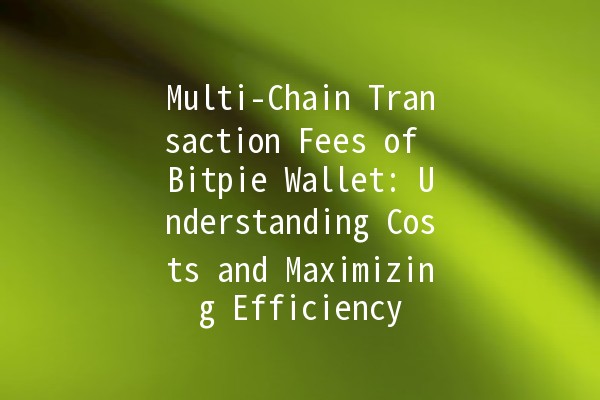




In the rapidly evolving digital currency landscape, the need for efficient and costeffective cryptocurrency management tools is paramount. Bitpie Wallet, known for its multichain support, enables users to efficiently manage a variety of cryptocurrencies with ease. However, as with any financial transaction, fees are an essential aspect to consider. Understanding these fees can help users make informed decisions and maximize their savings. This article delves into the multichain transaction fees associated with Bitpie Wallet, offering practical tips to improve productivity and minimize costs.
Multichain transactions involve transferring cryptocurrencies across different blockchain networks. Bitpie Wallet supports various chains such as Bitcoin, Ethereum, and more, allowing users to conduct transactions seamlessly. However, these transactions typically incur fees, which vary significantly depending on the blockchain network and the specific cryptocurrency used.

Identifying the fee structures and dynamics of multichain transactions is crucial for users who wish to optimize their transaction costs. Higher fees can significantly cut into potential profits, especially for frequent traders or those transacting smaller amounts.
Several factors affect the transaction fees associated with Bitpie Wallet:
During times of high volume, networks like Bitcoin and Ethereum can experience congestion. As more users compete to have their transactions processed, fees tend to rise. Keeping an eye on network status can help users time their transactions for lower fees.
The size of the transaction can influence the fees. Typically, larger transactions may incur higher fees. Understanding how to calculate fees based on transaction size can improve budgeting and costeffectiveness.
Transactions may vary in complexity—simple transfers may cost less than operations involving smart contracts or multisignature transactions. Users should familiarize themselves with the nuances of their transactions to anticipate potential costs.
To help Bitpie users minimize their transaction fees while maximizing the effectiveness of their cryptocurrency interactions, here are five actionable tips:
Explanation: Regularly check the current network status for your required blockchain. Websites like Blockchair or EthGasStation provide realtime fee estimations.
Application Example: If Bitcoin transaction fees are unusually high, consider delaying your transaction until the fees decrease or use a less congested timeframe.
Explanation: Transact during offpeak hours when network usage is lower.
Application Example: While cryptocurrencies trade constantly, Mondays and weekends may witness lower activity levels. If possible, plan your transactions during these times to take advantage of reduced fees.
Explanation: Many wallets, including Bitpie, allow users to set custom transaction fees based on their urgency.
Application Example: If you're not in a hurry, consider setting a lower fee. Your transaction may take longer but could save you significant amounts in fees.
Explanation: Consolidating transactions or batching them can reduce overall fees, especially on networks with lower transaction per unit costs.
Application Example: Rather than conducting multiple small transactions, group them into one larger transaction, which often has a lower total fee than multiple smaller ones.
Explanation: If converting cryptocurrencies, consider using decentralized exchanges (DEX) or other platforms that offer lower fees.
Application Example: Rather than switching cryptocurrencies within the Bitpie interface, explore using a DEX that charges lower fees for conversions, which can effectively reduce overall transaction costs.
To further assist users in grasping the fee structure, let’s consider a detailed analysis of various aspects:
Small Transactions: May incur higher relative fees as a percentage of the transaction itself as fixed fees apply.
Large Transactions: Tend to carry lower percentages but could still incur significant absolute fees depending on the network.
Using Bitpie to transact across various chains means being aware of the underlying fee structures of each blockchain involved. Fees on fast chains like Binance Smart Chain may differ significantly from Ethereum or Bitcoin.
Estimating potential transaction costs beforehand can prevent surprises. Bitpie and other wallets often provide fee estimators to assist in this planning.
Fees for Bitpie transactions are determined by several factors, including the cryptocurrency being used, network congestion, the size of the transaction, and Bitpie's service fees.
Users can check current fees using transaction fee estimators available online, such as EthGasStation for Ethereum or other block explorers for different cryptocurrencies.
Any potential hidden fees would typically be outlined in the user agreement or transaction details. Users are encouraged to review terms thoroughly to avoid surprises.
While there’s no guaranteed method, observing historical patterns can provide insight. Generally, weekends or less active trading periods tend to have lower fees.
Fixed fees remain constant regardless of transaction size, while variable fees may fluctuate based on network demand and transaction size.
Typically, once a transaction is processed, fees are nonrefundable, even if the transaction fails or is rejected by the network.
Understanding and managing transaction fees within Bitpie Wallet can significantly enhance your cryptocurrency experience. By implementing strategies to monitor and reduce fees, users can safeguard their investments and maximize their overall gains. We're available for any further questions or discussions you may have about managing multichain transactions effectively and efficiently.
This article should be seen as a starting point for those looking to navigate the complexities of multichain transactions and associated fees. By being informed and adopting best practices, users can efficiently manage their wallets and enhance their cryptocurrency journey.